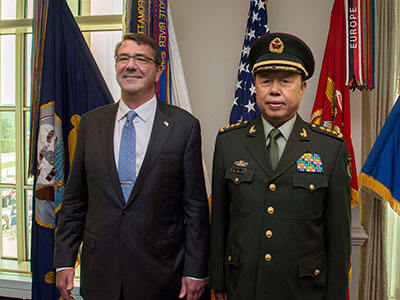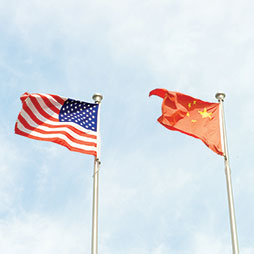Enhancing U.S.-China Military-to-Military Exchanges
In advance of the September 2015 meeting between Presidents Xi Jinping and Barack Obama, Roy Kamphausen (NBR) outlines challenges in U.S.-China military-to-military relations and discusses the opportunity provided by the upcoming summit to make new progress.
The U.S.-China bilateral military relationship is important but far from effective. Furthermore, tensions in this dimension of the relationship bode ill for the progress of the overall relationship. [1] Both Presidents Barack Obama and Xi Jinping have shown support for more robust military-to-military (mil-mil) ties, as demonstrated by the introduction of new confidence-building measures following their summit in November 2014. The upcoming summit provides an important opportunity to make new progress.
Challenges in U.S.-China Military-to-Military Relations
The principal challenge to greater mil-mil relations is that the U.S. military and the People’s Liberation Army (PLA) are at different stages of national development with different priorities. As the established power, the United States can hardly brook consideration of diminished or shared power. As the rising power, China seeks to redress old inequities and in some cases rewrite rules or norms of the international system. This dynamic directly affects the quality and content of the U.S.-China bilateral relationship, especially those instances where the two militaries seek to work together. While the two militaries cannot change this core dynamic, it makes their engagement fraught with more consequence than might otherwise be true.
A second challenge is that the two militaries have conflicting core national security interests. For China, U.S. naval and air activity off the Chinese littoral—even when conducted in international airspace and waters—puts at risk Chinese national security. China remains a strategically defensive-oriented armed force; its doctrine, disposition, and development reflect a national security strategy intended to defend the Chinese mainland. For Washington, new Chinese weapons systems, intensified claims to disputed territories in the East and South China Seas, and new activities (even when conducted by others first, such as land reclamation) give the strong impression that China seeks to displace the United States from normal operating areas in the Western Pacific and somehow inhibit freedom of navigation. Consequently, the United States must hedge against this undesirable development because it will not accept a reduction in its hard-won freedom of maneuver. Moreover, U.S. allies and security partners increasingly feel under pressure from China and seek stronger U.S. commitments in response. Neither military fully accepts the other’s assurances about benign intent, which negatively colors all engagements. Indeed, each military increasingly regards the other as an adversary.
China’s demonstrated willingness to use its military, coast guard, and other security services in “gray areas” in the South China Sea and elsewhere further complicates the regional security dynamic. These “non-war” activities, such as coast guard patrols or even the deployment of maritime militias, are insufficient to garner a combat response from the United States and indeed seem calculated to intentionally fall below the threshold of military conflict. But over time, their accumulated gains help skew regional security more toward Chinese ends.
Additionally, the two militaries share high levels of mistrust. The history of military interactions is replete with negative examples. For China, these include the United States’ abrupt termination of cooperative defense programs in 1989 following violent protests and loss of life in Tiananmen Square; the inadvertent, but inexplicable, launch of air-ground missiles into the Chinese embassy in Belgrade in 1999; the ongoing U.S. military presence in China’s exclusive economic zone; and the periodic announcement of new arms sales to Taiwan. All these incidents raised serious questions about American intent. For the United States, the mistrust has different origins. U.S. leadership helped create the peaceful environment in East Asia that has directly facilitated the postwar economic boom. Changes to the regional order suggest risk, both to U.S. leadership in the Asia-Pacific and to the broader regional order. Yet the level of mistrust is not ipso facto an inhibitor to greater cooperation; many senior leaders on both sides have argued that trust is not a precondition for cooperation but can be built over time.
Another challenge is that the two sides have dramatically different views about the goals of a mil-mil relationship. The United States sees the relationship as a means to mitigate tensions and demonstrate American power, perhaps helping build confidence along the way, albeit in a process that assumes enduring U.S. leadership. For the most part, the United States has not yet seen the relationship as one that is broadly able to deliver on addressing shared regional or security issues. For China, the true goals of a mil-mil relationship are to shape U.S. security behavior in ways that enhance broader Chinese deterrent goals. While the PLA still seeks to learn from U.S. experiences in order to aid its own modernization efforts, China believes that Washington gains more from these exchanges than Beijing does, suggesting diminished incentives for cooperation. Put differently, each side has instrumental goals for the relationship; neither sees mil-mil relations as essential to achieving broader regional aims.
Finally, both countries face real domestic constraints. The U.S. National Defense Authorization Act of 2000 (as amended in 2010) limits the types of operational engagement in which the United States can participate. The U.S. Congress remains keenly concerned with security developments in East Asia and closely monitors bilateral U.S.-China mil-mil relations as a result to ensure that U.S. allies and partners are not let down. For its part, China is in the midst of a broad-based anticorruption campaign, and its military is undergoing significant structural reform. Meanwhile, it eschews involvement in other countries’ internal affairs—and strongly opposes intervention in its own internal affairs, including Taiwan—while avoiding participation in U.S.-led coalitions.
Recommendations for the United States
While the possibility of conflict between the two militaries is not high, the United States can ill afford to stumble into a new conflict, given simmering tensions elsewhere. To a much greater extent, it must employ the non-war uses of its military power. Military presence and diplomacy, as well as exercises with allies and partners, are traditional strengths of the U.S. armed forces, but the reduction of the full spectrum of options for U.S. leaders requires new approaches to achieve security objectives. Both building cooperation in areas of shared goals and agreeing on mechanisms to manage tension and crises are urgently needed to complement existing approaches to U.S.-China military relations.
During President Obama’s November 2014 visit to China, he and Xi agreed to mil-mil confidence-building measures in two areas: “notification of major military activities” and “rules of behavior for the safety of air and maritime exercises and activities.” These are important steps that address to a certain extent the major issue that each side has with the other: China is concerned about the presence of the U.S. military near the Chinese mainland, and the United States is concerned about the safe operation of its aircraft and ships anywhere, but especially when they operate near those of the PLA.
However, these measures are only first steps. The development of a framework for cooperative engagement on issues of common global and regional security would help the mil-mil relationship move beyond its current self-referential stage, and in the process build some trust. Whether this would diminish the core political and security concerns that each country has with the other is probably the wrong question to ask. The structural challenge embedded in the engagement between a rising and established power cannot be solved through mil-mil activities alone. That said, Presidents Obama’s and Xi’s development of a collaborative agenda that delivers security goods on a range of regional and global security issues could help change the focus of the relationship.
Endnotes
[1] That military-to-military relations have often served as a convenient scapegoat dimension—with cancellation or reduction of contacts in response to a crisis event being a way to signal displeasure that avoids putting the overall relationship out of whack—reflects the subordinate importance of the dimension. Thus, making military-to-military engagement the lead in any bilateral relationship is a precarious, and often unsustainable, policy position.




